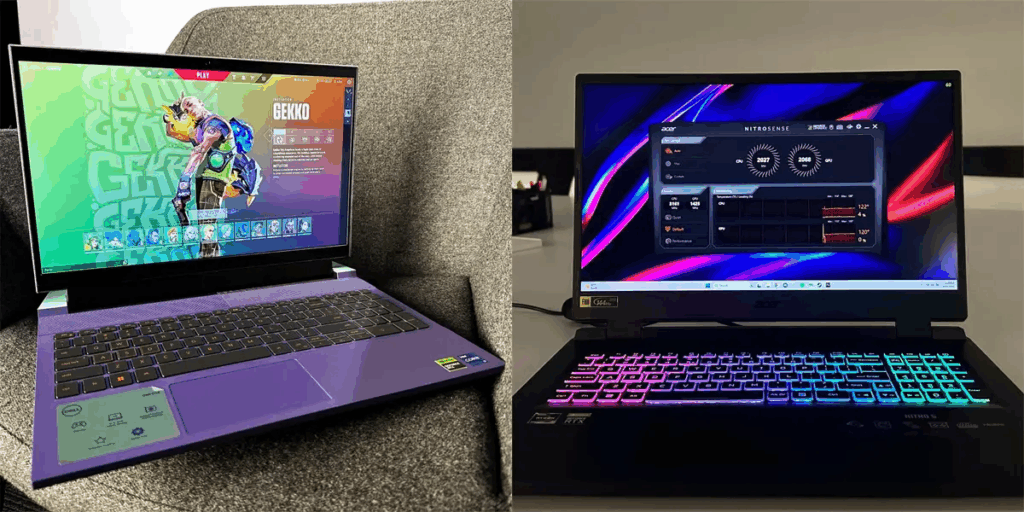The gaming laptop industry is evolving rapidly, with new advancements in hardware, design, and software changing how we experience gaming on the go. In 2026 and beyond, the future of gaming laptops promises to be exciting, with innovations that will not only enhance gaming performance but also offer entirely new experiences. Let’s take a closer look at some of the most promising trends and technologies shaping the next generation of gaming laptops.

1. Foldable and Flexible Screens
One of the most anticipated innovations in the gaming laptop world is the integration of foldable and flexible screens. Foldable technology, which is already gaining traction in smartphones, is expected to make its way into gaming laptops, creating a new category of ultra-portable devices with large screens.
What to Expect:
- Larger Displays in Smaller Form Factors: Imagine being able to unfold your gaming laptop to reveal a 17-inch or even 18-inch screen, but still having a compact device that fits in a bag when closed. These foldable displays will allow for much larger screens without sacrificing portability.
- Immersive Dual-Screen Designs: Foldable screens could also enable dual-screen configurations. For example, a single folding screen could expand into a wide-format display, or the screen could split into two separate panels, allowing for an immersive experience with game controls on one half and gameplay on the other. This would provide a dynamic, multitasking setup that would be ideal for streamers or multi-player gaming.
Challenges:
- Durability and screen longevity are key concerns with foldable displays, as folding mechanisms may wear out over time. However, advances in material science, like the use of foldable OLEDs, should help mitigate these issues.
2. Enhanced Graphics with Ray Tracing and AI Integration
Graphics technology in gaming laptops has come a long way, and the next frontier lies in ray tracing and AI-powered enhancements. Ray tracing, which simulates how light interacts with objects in real time, has already taken gaming visuals to a new level, but it’s expected to evolve further as GPUs become more powerful.
What to Expect:
- More Realistic Graphics: In 2026 and beyond, expect next-gen ray tracing capabilities to be standard across gaming laptops, with real-time reflections, better lighting effects, and more realistic shadows becoming a common feature in games.
- AI-Powered Graphics: GPUs powered by AI will not only make games look better but also run smoother. AI will be used to upscale lower-resolution textures in real-time and optimize frame rates based on what’s happening on screen, delivering higher-quality visuals without overloading the GPU.
- DLSS 3.0 (Deep Learning Super Sampling) and similar AI technologies will allow gaming laptops to render ultra-high-definition graphics without a significant performance hit, enabling smoother frame rates and more detailed environments.
Challenges:
- Even with AI, ray tracing is extremely resource-heavy. However, the next-gen GPUs like NVIDIA’s RTX 5000 series or AMD’s RDNA 4 architecture will likely handle these tasks with more efficiency and lower power consumption, making ray tracing a standard feature even in laptops.
3. Ultra-Powerful, Energy-Efficient Processors
As gaming laptops continue to pack more performance into thinner and lighter designs, the demand for powerful yet energy-efficient processors will grow. Future gaming laptops will be equipped with processors that not only deliver exceptional gaming performance but also consume less power, ensuring longer battery life during intensive gaming sessions.
What to Expect:
- Mobile Versions of Desktop CPUs: Expect to see more powerful versions of desktop processors, such as Intel’s Alder Lake or AMD’s Ryzen 7000 series, adapted for mobile form factors. These processors will offer more cores and threads, improving multitasking and overall system performance.
- AI-Driven Power Management: Advanced power management technologies will use AI to dynamically adjust the CPU and GPU performance depending on the task at hand. When you’re gaming, your laptop will push its resources to maximize performance, but during lighter tasks (like browsing or watching videos), it will automatically throttle down to save power.
- Better Battery Performance: With improvements in battery chemistry and fast charging technologies, you’ll see gaming laptops capable of delivering hours of gaming with shorter charging times. Batteries could also become more integrated into the laptop chassis, allowing for slimmer designs.
Challenges:
- Balancing power and battery life with portability and cooling remains a challenge. Gaming laptops generate a lot of heat, so thinner and more powerful devices will require better cooling systems.
4. 5G Connectivity for Cloud Gaming and Seamless Multiplayer
The future of gaming is not just about powerful local hardware but also about seamless cloud gaming and online multiplayer experiences. The rollout of 5G networks will enable gaming laptops to access cloud-based games without relying on powerful local hardware.
What to Expect:
- Cloud Gaming at Its Best: With 5G, gamers will be able to play high-quality games hosted on remote servers, streaming directly to their laptops with minimal latency. This means that even if your laptop isn’t equipped with the latest GPU, you can still play demanding AAA games with high graphics settings, just like playing them locally.
- Lag-Free Online Gaming: Multiplayer games like Fortnite, Call of Duty, and League of Legends will benefit from faster, more reliable connections. The 5G network will reduce lag and allow for smoother online gameplay, especially in crowded lobbies or large-scale battle royales.
Challenges:
- While 5G connectivity promises faster speeds, network availability and data caps could still present challenges in some regions. Additionally, cloud gaming services will require consistent high-speed internet, which may not always be available in rural or underserved areas.
5. Holographic and Augmented Reality Displays
As virtual reality (VR) and augmented reality (AR) become increasingly mainstream, gaming laptops may integrate holographic displays or AR capabilities to bring immersive gaming experiences to life. These new display technologies will allow gamers to interact with their environment in a more realistic way.
What to Expect:
- AR/VR Headset Compatibility: In the future, gaming laptops will be designed to seamlessly integrate with AR or VR headsets. Expect laptops to include dedicated ports and hardware optimizations for these immersive technologies, allowing you to dive into virtual worlds with ease.
- Holographic Displays: Though still in its infancy, holographic gaming displays are a possibility for the future. Imagine gaming without a traditional screen, using 3D projections to bring your games to life in your room. While this technology is still in its experimental stages, it could revolutionize how we interact with games and media.
Challenges:
- The technology required for holographic displays and true AR gaming is complex and will require significant advancements in both hardware and software. These features may still be years away from being viable in consumer laptops.
6. Better Audio, Microphones, and Webcams for Streamers
Streaming has become a massive part of gaming culture, and gaming laptops are increasingly focusing on improving audio quality, microphones, and webcams for content creators.
What to Expect:
- Built-in High-Quality Microphones: Future gaming laptops will come with built-in studio-quality microphones that eliminate background noise and capture clear, crisp audio for streamers without the need for external microphones.
- 4K Webcams: As streaming platforms adopt higher resolutions, expect laptops to be equipped with 4K webcams that deliver sharp and professional-quality video, ideal for streamers.
- Dolby Atmos Sound: The integration of Dolby Atmos or similar spatial audio technologies will ensure that gaming laptops deliver immersive, surround-sound experiences, making them perfect for both gaming and streaming.
Conclusion: The Future is Bright for Gaming Laptops
The future of gaming laptops is packed with exciting advancements, from foldable screens and AI-powered graphics to 5G cloud gaming and immersive AR experiences. In 2026 and beyond, gaming laptops will not only be powerful machines for playing the latest games but will also transform how we interact with games, stream content, and connect with the gaming community. As technology continues to evolve, we can expect laptops that push the boundaries of performance, portability, and immersion.
Gaming laptops are becoming more than just devices—they’re transforming into hubs for entertainment, content creation, and virtual worlds, and the best is yet to come!
